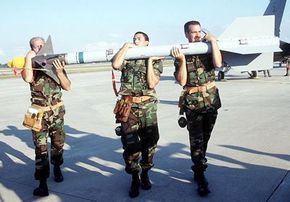Heat Sensing
In 1947, a Naval physicist named Bill McLean took it upon himself to build a better system -- a missile that would seek out the heat from an enemy aircraft's engine system. Since the missile would home in on the target's own emitted energy, rather than reflected radio energy, the pilot could "fire and forget" -- that is, he could launch the missile and get clear. In place of the bulky radar equipment, the missile would use a relatively small heat-sensing photovoltaic cell to "see" the target. This meant it could be built much smaller than the current radar prototypes, and at a much lower cost.
Officially, the Navy had no interest in non-radar guidance systems, but at the China Lake, California, Naval Ordnance Test Station (NOTS) where McLean was employed, researchers had enough freedom to pursue unconventional projects. Under the guise of missile fuze development, McLean and his colleagues worked out the design of the first Sidewinder prototypes. Six years later, in September 1953, the missile had its first successful test run.
Advertisement
Since that time, the Sidewinder has taken a number of different forms, each model adding new technology and capabilities (check out F-16.net: AIM-9 Sidewinder for details on the specific models). While today's semiconductor guidance systems are a lot more advanced than the vacuum tubes on the original designs, the overall operation is pretty close. In the next couple of sections, we'll examine the current Sidewinder model, the AIM-9M, and also take a peek at its upcoming replacement, the AIM-9X.
